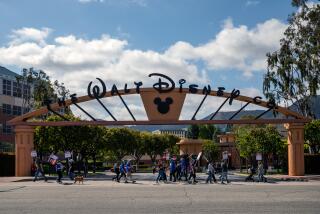Disney profits top Wall Street estimates as streaming wars begin
Walt Disney Co. reported fourth-quarter earnings that topped Wall Street expectations, capping a year of dramatic change for the company ahead of the launch of its all-important new streaming service.
The Burbank entertainment company posted profit of $1.07 a share for the three months that ended in September. Though that was down 28% from the same period a year ago, the results exceeded the 94 cents a share that analysts were expecting. Revenue for the quarter grew 34% to $19.1 billion. Analysts polled by FactSet had projected revenue of $19.18 billion, on average.
The drop in profits came as Disney and Chairman and Chief Executive Bob Iger are making a bold and expensive play to reshape the business for the streaming future. Disney is making a substantial investment to grow its direct-to-consumer business with Disney+, which is set to launch Tuesday in a bid to take on established players like Netflix and new offerings from AT&T, NBCUniversal and Apple. The company also took operational control of money-losing Hulu this year, which has weighed on profits.
Executives have been clear that the investments in streaming are not about short-term profits but about positioning Disney for continued success in the fast-changing entertainment business. The company expects Disney+ to be profitable by fiscal 2024 and amass 60 million to 90 million subscribers worldwide.
Heavy spending on streaming is necessary to make a success out of Disney+, which will charge subscribers $6.99 a month, or $70 for those who sign up for a full year. The heavily marketed streaming platform includes an enviable vault of animated and live-action Disney classics, Marvel movies, the “Star Wars” pictures, Pixar films and a robust slate of original titles, including the “Star Wars” series “The Mandalorian.” The company is projected to invest more than $1 billion in content for Disney+ in fiscal 2020.
“With the launch of Disney+ we’re making a huge statement about the future of media and entertainment and our continued ability to thrive in this new era,” Iger said in a call with analysts.
Disney’s stock rose 5% in after-hours trading following the earnings report. The shares had closed Thursday at $132.96.
Disney shared more details about the international rollout of Disney+, which will launch in Australia and New Zealand on Nov. 19 after it goes live in the U.S., Canada and the Netherlands next week. Disney+ will debut in Western European countries including Britain, France, Germany, Spain and Italy on March 31, Iger said.
He also said Disney had secured deals to make the service available through Amazon Fire, Samsung and LG platforms, after already getting distribution agreements with Apple, Google, Microsoft, Sony and Roku. The additional deals give the service a broader reach through consumers’ devices.
Disney+ will focus on family-friendly brands, and more adult-oriented content, including material from Disney’s Fox assets acquired this year, will gravitate to Hulu. Iger said Hulu will become the official streaming home of FX Networks, which is producing four original shows for the streamer. FX’s past series will also stream on Hulu, which has about 28.5 million subscribers. Disney+ will be available through a bundle that includes Hulu and sports streaming service ESPN+ for $12.99 a month.
Quarterly results were boosted by a big showing from Disney’s film studio business, which had major hits including “The Lion King,” “Aladdin” and “Toy Story 4.” The studio delivered operating profit that soared 79% to $1.08 billion on revenues of $3.3 billion. However, the studio took a hit from movies from the 20th Century Fox studio, which lost $120 million in the quarter, the company said. Fox flops included the Brad Pitt space movie “Ad Astra.”
Disney’s parks and consumer products business made $1.4 billion in operating income, up 17% from the prior year thanks to greater merchandise sales and higher spending and ticket prices at Disneyland Resort in Anaheim. Results were offset by lower attendance at Disneyland and costs from operating the new Star Wars: Galaxy’s Edge attraction. Attendance at Galaxy’s Edge, which has also opened at Walt Disney World Resort in Florida, disappointed after its opening as some fans waited to visit until the opening of the attraction’s second ride. But Iger pushed back against the notion that Galaxy’s Edge was struggling. The technologically advanced Millennium Falcon ride has carried more than 1.7 million guests, Iger said.
“Those two lands have been far more successful than has been reported,” Iger said.
Meanwhile, protests against the Chinese government in Hong Kong weighed on results from Disney’s park in the semiautonomous region.
The company’s media networks division lagged, with profit decreasing 3% to $1.8 billion. Income fell because of a decrease at cable network ESPN, lower program sales from ABC Studios and higher programming costs at the ABC television network.
The direct-to-consumer unit, which includes Disney+, ESPN+ and Hulu, was a drag on profits as Disney escalated investment. The division lost $740 million, compared with a loss of $340 million a year ago.
The company also reported full fiscal year earnings. Net income totaled $10.4 billion, down 17% from fiscal 2018. Sales increased 17% to $69.57 billion.
More to Read
Inside the business of entertainment
The Wide Shot brings you news, analysis and insights on everything from streaming wars to production — and what it all means for the future.
You may occasionally receive promotional content from the Los Angeles Times.











